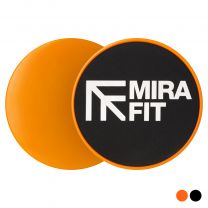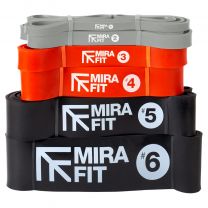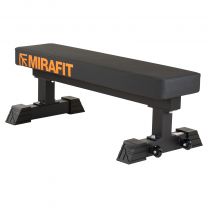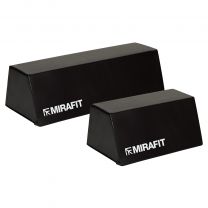Top Ten Hip Exercises to Prevent Injury
Top Ten Hip Exercises to Prevent Injury

Do you suffer from tight hips? Have hip stretches stopped working for you? Or have you never experienced any hip problems…. yet? The hip forms the all-important link between the upper and lower body. When you load the upper body, the hips have to distribute the load through the leg. When you are loading the legs, such as squatting or running, your legs have to transfer the load through the hips. So whether you experience hip pain or not, healthy hips are essential for a healthy, pain free body.
What Are the Hips?
The hips consist of a group of bones that articulate with the top of the femur bones of the legs on the one side and the base of the spine on the other. They allow a large amount of motion including the following -
• Flexion - Bending of the body forward at the hips (Iliopsoas and Rectus Femoris (abs))
• Extension - Movement of the legs backwards (Glute Maximus and Hamstring)
• Abduction - Movement of the legs away from the midline of the body (Glute Medius and Glute Minimus)
• Adduction - Movement of the legs towards the midline of the body (Adductor Longus and Adductor Brevis)
• Internal Rotation - Movement of toes towards midline of the body by rotating femur inwards (Glutes Minimus and Adductors)
• External Rotation - Movement of toes away from the midline of the body by rotating femur outwards (Glute Maximus and Piriformis)
How To Increase Hip Mobility
Sore or tight hips? Your first response is to stretch them. While this might provide short term relief, it is not going to solve the problem. Due to our lifestyle which includes large amounts of time sitting, our hips tend to tilt forwards instead of being in a more neutral position.
With the hips tilting forward, the hip flexor muscles end up being overstretched and trying to stretch them more is not the solution. Rather we need to reposition the hips by tilting them back towards a neutral position. To make a permanent change to tilting of the hips we need to strengthen muscles surrounding the hips while the hips are in the correct position. This largely involves the Iliopsoas and glute maximus muscles. The best exercise for this is the Psoas March.
When stretching is needed as a solution to poor mobility, particularly with internal and external rotation where tilting of the hip is not an issue, you should perform the required stretch followed by a contraction such as an isometric exercise. This helps reinforce the change in mobility by strengthening in that position. Exercises such as the Hip PAILS and RAILS are excellent.
Get Stable Hips
The last thing you want from your hips is for them to collapse or lose form under loads. This is commonly seen in runners when one side of the hips is weaker, causing the opposite leg to collapse and they end up running with their feet flaring out to the side. Strong Glute Medius muscles are important to prevent this and you can do that with exercises such as the Monster Walk.
The Weak Link in the Chain
Your musculoskeletal system is like a chain. A weakness caused by a muscle or tendon will affect the other structures surrounding it. With the hips being such a pivotal link in the body it is essential for it to be strong, so the rest of the body doesn’t suffer.
A good example is a weak Glute Maximus. If this is too weak then the hamstring has to pick up the strain when it comes to extension motions such as when the leg moves backwards when sprinting. If the hamstring has to do too much of the work on its own, then an injury is a short sprint away. Bullet proof your hamstring by getting strong glutes with exercises such as the Glute Bridge.
The Top Hip Exercises
1 - Psoas March

The Psoas March is an excellent exercise to help prevent the sensation of tight hips. By having your legs raised, you are positioning the hips neutrally and then by activating the muscles through the exercise you reinforce the change in the hip position.
• Loop a Resistance Band around a Power Cage.
• Lie on your back with your feet inside the loop and your legs raised with a slight tension in the resistance band.
• Activate your core by squeezing your abs.
• Hold this position and pull a single leg towards your chest while the other leg stays elevated.
• Return to the starting position and repeat with the opposite leg.
2 - Kneeling Hip Stretch

There are times when the hip needs to be stretched. The best way to do this is to make sure that you are stretching the hip flexors with the hips in the correct position and then follow up the stretch with an exercise like the psoas march.
• Get into a half kneeling position with the knee of one leg on a mat and the opposite leg bent at 90 degrees. Raise both arms above the head to get a better stretch.
• Tuck your tailbone under your hips. Holding this position, slightly push the hips forward and hold this position for 30 seconds.
• Return to the start position, keep the tailbone tucked under the hips and lean sideways away from the knee that is on the ground. The arm on the same side as the knee that is on the ground can reach up and over your head. This will place more emphasis on the lateral part of the hip muscles.
3 - Copenhagen Plank
The adductors are often neglected in training as they are not highly active in the main exercises such as squats and deadlifts. A standard side plank works the lateral side of the body including the abs and Glute Medius. By doing the Copenhagen plank on a Weight Bench you are able to target the adductors.
• Lie on your side and place one leg on top of a bench with the other foot below on the floor.
• Position your body so it is in a straight line with you elbow directly below your shoulder.
• Push your hips off the ground so that your body is straight, and the hips don’t collapse.
• Now lift the foot that was on the floor up to the bench and squeeze the bench with both feet.
4 - Banded Hip Flexion
Another great exercise to target the Iliopsoas. This exercise also requires hip stability and therefore activates the glute medius as well.
• Loop a resistance band around a power rack.
• Stand with one leg inside the loop and your back towards the rack. There should be a light tension in the hip.
• Tighten your abs and lift your knee high as if you are running so that your foot is underneath your bum, thigh parallel to the floor and toes pulled up.
• Pause and stabilise in this position before lowering the leg to the start position.
5 - Clam Plank
The standard clam exercise is important to strengthen the glute medius. By combining it with a side plank you are raising the intensity of the exercise as well as targeting the glute medius and oblique abdominals.
• Loop a mini resistance band around your legs so it is just above your knees.
• Lie on your side with your legs bent at 90 degrees and your elbow below your shoulder.
• Push your hips off the floor so that you form a straight line from your knees to your head.
• Keeping your heels together, open the top leg against the resistance of the mini band and then return to the start, maintaining a stable plank position the entire time.
6 - Goblet Squat

By holding a Kettlebell in front of you during a squat you are able to offset the imbalance that you would experience during a back squat. This allows you to keep a more upright body and to lower your hips further than you would with a back squat. This increased range of motion will help improve hip mobility as well as strengthen the glutes.
• Hold a kettlebell to your chest with your arms tucked in.
• Stand in a squat position with your feet a bit more than shoulder width apart and your toes slightly out.
• Lower yourself into a squat. Try to go as low as possible without losing the neutral spine.
• Drive through the heels and squeeze the glutes to get back to the starting position.
7 - Glute Bridge

This is one of the best exercises to target the glute maximus. This will help prevent hamstring injury as well as improve the posture of the hips.
• Lie with the middle of your back on the edge of a Hip Thrust Bench.
• Have your legs bent with your feet in line with your hips.
• Position the barbell across your hips and hold onto it.
• Squeeze your glutes to push them towards the ceiling.
• Slowly lower and repeat the exercise.
8 - Monster Walk - Sideways, Forwards and Backwards

If you are suffering from unstable hips or weak knees this is a great exercise to do. It gives your glute medius, which is your major knee stabiliser, a great workout as well as strengthening the hips so they don’t collapse while you are running.
• Loop a resistance band under each foot.
• Grab the loose end in front of you and adjust resistance.
• Start with your feet hip width apart and move sideways, starting with same leg as the side that you are moving towards.
• After 10m change direction to move in the opposite direction.
• Keeping the feet, the same hip width apart, move forwards for 10m and then walk backwards for 10m.
9 - Side Lunge with Sliders

The side lunge on its own is an important exercise. It works the quads, glutes, hamstring and adductors. By using Core Sliders you can really target those hip adductors. You are also able to load the exercise by including dumbbells.
• Start with your feet under your hips, one foot on the slider and some dumbbells in your hands.
• Push your hips back as if you were going into a squat and at the same time slide the one leg out to the side, keeping the leg straight. You should feel like you are doing a one-legged squat with one leg while the other is stretched out to the side.
• Now stand up by pushing through the heel of the leg squatting while you pull the other leg back towards your midline.
10 - 90/90 Hip PAILS and RAILS

Let's start with what PAILS and RAILS are. As mentioned above, stretching alone has a short-term effect. Once we have stretched a muscle, we want to make the change more permanent by strengthening the muscle in this new position. This is where Progressive Angular Isometric Loading and Regressive Angular Isometric Loading come in.
The PAIL targets the muscles that are in the lengthened position during the exercise while the RAIL targets the muscle that is being shortened during the stretch. This form of mobility will increase your range of motion as well as adapting the nervous system to use the muscles in this range.
• Get into a 90/90 position by having one leg out in front of you with the knee in line with the same shoulder and the knee bent at 90 degrees. Position the other leg so that it is out to the side of your body at a 90-degree angle from your chest and the knee also bent at 90 degrees.
• Push yourself up into an upright position by supporting yourself with the same arm as the leg that is in front of you.
• Keeping your spine “tall”, lean forward towards the bent leg so that you are leaning forward from the hips and your back doesn’t round.
• Hold this stretch for 1 minute.
• Keeping in this position you are now going to push the shin of your front leg into the ground. To do this we are going to ramp up the tension by slowly applying more pressure against the ground until we reach 100%. Once you have reached 100% hold for 10 seconds.
• After 10 seconds immediately reverse the direction and now try to lift the lower leg off the floor with 100% effort. You should still be in your stretch position and it should only be the sensation of you lifting the lower leg off the floor as there shouldn’t be any actual movement.
• Hold this for 10 seconds then slowly relax and stay in the stretch position for another 10 seconds.
Poor hip strength and mobility can become debilitating and cause a range of posture or imbalance issues. As can be seen from some of the exercises above, you can easily include them in your routine and you don’t have to dedicate an entire session to them. Make sure your hips are not the weakest link and prevent hip mobility issues which will also help improve your overall strength and conditioning.
Written by guest author Brendan McBirnie.
For more content, follow us on Instagram, YouTube, TikTok, and on our official Mirafit Facebook page.
Enter your email to signup to our newsletter







